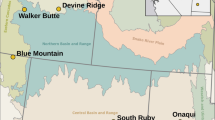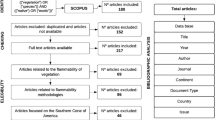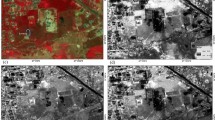Abstract
There are areas in the boreal forest where the combination of highly flammable vegetation and frequent ignition events create a high fire hazard. The resultant fires cause considerable economic and social damage. During global change, fire frequency may increase in parts of the boreal forest. We are investigating the feasibility of using less-flammable vegetation to reduce the number of people-caused fires in herbaceous communities of northern Ontario. Herbaceous species abundant in these areas were ranked according to potential ignitability. Ignitability was estimated from chemical and physical fuel characteristics measured on live and dead tissue.Achillea millefolium, Aster macrophyllus andAnaphalis margaritacea had the lowest potential ignitability. Their rank was consistent for fuel characteristics measured on live and dead leaf tissue. Many of the commercially available forbs tested (e.g.,Trifolium spp.) were of low to intermediate ignitability. Grass species such asPoa compressa andAgrostis scabra had the highest potential ignitability. Physical characteristics were not significantly correlated with chemical characteristics (p >0.05, n=20). There was a significant but trivial correlation between surface area to volume ratio and volume (r=-0.80, p ⩽ 0.05, n=20). There was a significant correlation between surface area to volume ratio and density (r=0.54, p ⩽ 0.05, n=20). There was a significant correlation between total ash and silica-free ash content (r=0.61, p ⩽ 0.05, n=47), between total ash and energy content (r=−0.55, p ⩽ 0.05, n=47) and between silica free ash and energy content (r=−0.28, p ⩽ 0.05, n=47). Research is continuing to-evaluate the feasibility of using less-flammable plants for fire hazard reduction. Planting less-flammable vegetation in fire prone areas, or around property and fire-sensitive natural areas, may help prevent ignition or slow fire spread. This technique could be a long term, cost effective and environmentally friendly method of fire prevention and control in selected areas of the boreal forest.
Similar content being viewed by others
References
Allen, S. E., Grimshaw, H. M. and Rowland, A. P.: 1986,In: Moore, P. D. and Chapman, S. B., (eds)Methods in Plant Ecology, Blackwell, Oxford, UK, 589 pp.
American Society for Testing and Materials: 1993, Standard Test Method for Gross Calorific Value of Coal and Coke by the Adiabatic Bomb Calorimeter,In: ASTM Committee E-5 on Fire Standards,ASTM Fire Test Standards, ASTM D 2015-93, American Society for Testing and Materials, Philadelphia, USA, 1148 pp.
Anderson, H. E.: 1970,Fire Technol. 6, 312–322.
Anonymous: 1969,Instructions for 1241 and 1242 Adiabatic Calorimeters, Parr Instrument Company, Moline, USA, 23 pp.
Blackmarr, W. H.: 1972,Moisture Content Influences Ignitability of Slash Pine titter, U.S. Department of Agriculture Forest Service Southeastern Forest Experiment Station, Asheville, USA, 7 pp.
Blackmore, D. G. and Corns, W. G.: 1979,For. Chron. 55, 102–105.
Byram, G. M.: 1959,In: Davis, K. P. (ed),Forest Fire Control and Use, McGraw-Hill, New York, USA, 584 pp.
Chandler, C, Cheney, P., Thomas, P., Trabaud, L. and Williams, D. (eds.): 1983,Fire in Forestry: Volume I, Forest Fire Behavior and Effects. Krieger Publishing Company, Malabar, USA. 450 pp.
Chapman, S. B.: 1986,In: Moore, P. D. and Chapman, S. B., (eds.)Methods in Plant Ecology, Blackwell, Oxford, UK, 589 pp.
Corns, W. G. and Schraa, R. J.: 1962,Can. J. Plant Sci. 42, 651–659.
Dore, W. G. and McNeill, J.: 1980,Grasses of Ontario, Research Branch, Agriculture Canada, Hull, Canada, 566 pp.
Frandsen, W. H.: 1987,Can. J. For. Res. 17, 1540–1544.
Gardner, W. D. and Thomson, C. R.: 1991,Fire and Materials 15, 3–9.
Gill, A. M. Trollope, S. W. and MacArthur, D. D.: 1978,Aust. J. For. Res. 8, 199–208.
Gleason, H. A. and Cronquist, A.: 1991,Manual of Vascular Plants of Northeastern United States and Adjacent Canada, The New York Botanical Garden, Bronx, USA, 910 pp.
Mak, E. H. T.: 1988,For. Sci. 34, 523–529.
Martin, R. E., Gordon, D. A., Gutierrez, M. E., Lee, D. S., Molina, D. M., Schroeder, R. A., Sapsis, D. B., Stephens, S. L. and Chambers, M.: 1994,In: Proceedings of the 12th Conference on Fire and Forest Meteorology, Society of American Foresters, Bethesda, USA, 796 pp.
Merzhanov, A. G. and Averson, A. E.: 1971,Combustion and Flame 16, 89–124.
Montgomery, K. R. and Cheo, P. C.: 1969,Amer. J. Bot. 56, 1028–1032.
Montgomery, K. R. and Cheo, P. C.: 1971,For. Sci. 17, 475–478.
Mutch, R. W.: 1964,J. Appl. Chem. 14, 271–275.
Philpot, C. W.: 1970,For. Sci. 16, 461–471.
Philpot, C. W. and Mutch, R. W.: 1968,Flammability of Herbicide Treated Guava Foliage, U.S. Department of Agriculture Forest Service, Intermountain Forest and Range Experiment Station, Ogden, USA, 9 pp.
Rothermel, R. C.: 1972,A Mathematical Model for Predicting Fire Spread in Wildland Fuels, U.S. Department of Agriculture Forest Service, Intermountain Forest and Range Experiment Station, Ogden, USA, 40 pp.
Sokal, R. R. and Rohlf, F. J.: 1981,Biometry. The Principles and Practice of Statistics in Biological Research, Freeman, New York, USA, 859 pp.
Stocks, B. J.: 1993,For. Chron. 69, 290–293.
Stockstad, D. S.: 1976,Spontaneous and Piloted Ignition of Cheatgrass, U.S. Department of Agriculture Forest Service, Intermountain Forest and Range Experiment Station, Ogden, USA, 12 pp.
Sylvester, T. W. and Wein, R. W.: 1981,Can. J. Bot. 59, 898–907.
Xanthopoulos, G. and Wakimoto, R. H.: 1993,Can. J. For. Res. 23, 253–258.
Author information
Authors and Affiliations
Rights and permissions
About this article
Cite this article
Hogenbirk, J.C., Sarrazin-Delay, C.L. Using fuel characteristics to estimate plant ignitability for fire hazard reduction. Water Air Soil Pollut 82, 161–170 (1995). https://doi.org/10.1007/BF01182830
Issue Date:
DOI: https://doi.org/10.1007/BF01182830




